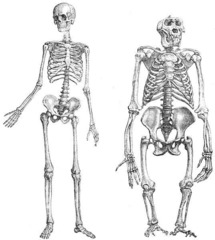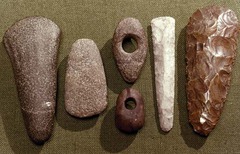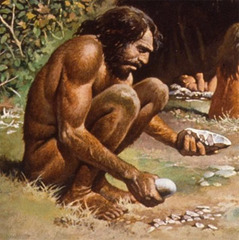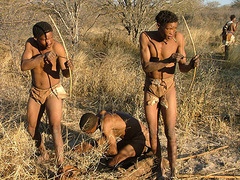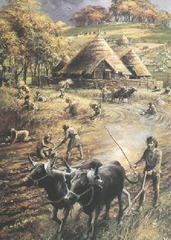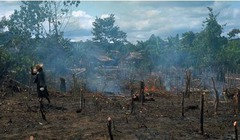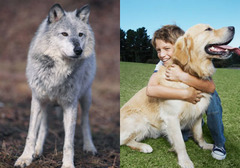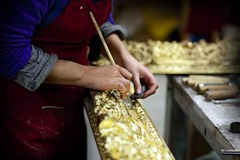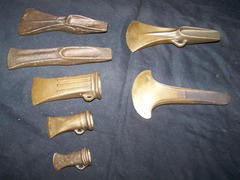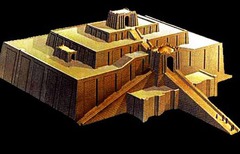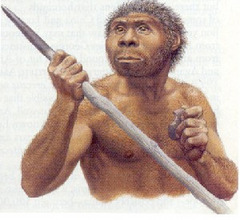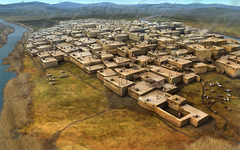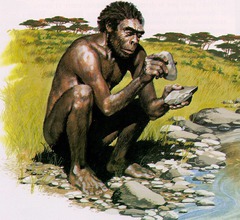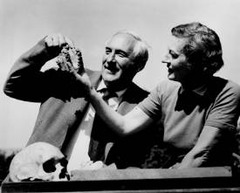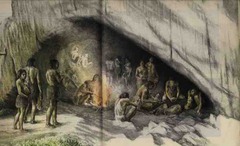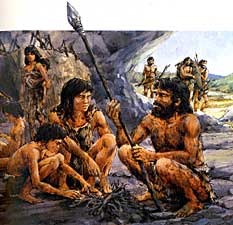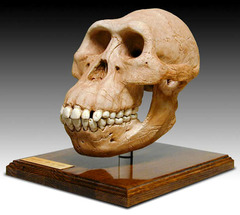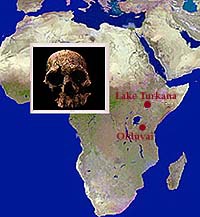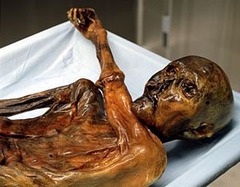Artifact
A human made object, such as tools and Jewlery.
Culture
A People's unique way of life.
Hominid
Humans and other creatures that walk upright.
Paleolithic Age
A period of time, also known as the Old Stone Age, that lasted from about 2.5 million yr. to 8000 B.C.
Neolithic Age
A period of time, also known as the New Stone Age, that began around 8000 B.C. and lasted until around 3000 B.C. People during this time learned to polish stone tools, make pottery, grow crops, and raise animals.
Technology
The way that people use knowledge, tools, and inventions to meet their needs.
Homo Sapiens
The species name for modern humans that means "Wise Men". While Homo Sapiens may have physically resembled Homo Erectus, they had larger brains.
Nomad
A highly mobile people group who move from place to place foraging, or searching, for new sources of food.
Hunter-Gatherer
Nomadic groups whose food supply depends on hunting animals and collecting plants for food.
Neolithic Revolution
Also known as the Agricultural Revolution, when people went from hunting and gathering for their food to farming.
Slash-and -Burn Farming
When people cut down trees or grasses and burned them in order to clear land for farming.
Domestication
The taming of wild animals such as horses, dogs, and pigs, for human use.
Civilization
A complex culture with five characteristics; 1) Advanced Cities, 2) Specialized Workers, 3) Complex Institutions, 4) Record Keeping, and 5) Advanced Technology.
Specialization
The development of skills in a specific kind of work.
Artisan
Skilled workers who make goods by hand.
Institution
A long-lasting pattern of organization in a community such as government, and religion.
Scribe
These were professional record keepers.
Cuneiform
This means wedge-shaped. This was a form of writing developed by Sumerian scribes which used pictographs, or symbols, to show the meaning of a word.
Bronze Age
This period started in Sumer around 3000 B.C. when people started to use bronze to make weapons instead of stone and copper.
Barter
A way of trading goods and services without using money.
Ziggurat
A tiered, pyramid shaped temple, used as a place of religious worship. The word means "Mountain of God".
Homo Erectus
Meaning 'upright man', these human like creatures lived about 1.6 million years ago. They are believed to have developed technology, used fire, and had a spoken language. These people are also believed to have been the first to have migrated from Africa.
Catal Huyuk
This site is believed to be one of the oldest settlements in the world. The people, who lived here around 72,000 years ago, in the Neolithic age, were farmers lived in mud brick houses.
Ur
This was a thriving city-state, in the region of Sumer, in what is now Southern Iraq. The people of this city had a class system, religious orders, and a thriving economy which were helped by their ability to irrigate their crops.
Homo Habilis
A term meaning 'Man of Skill'. Remains of these people were found in Oldavai Gorge, in Tanzania, by Louis and Mary Leakey.
Prehistoric
This was a time period around 5000 years ago, before writing was invented.
Lucy
This was the adult skull of a female Hominid, discovered by Donald Johnson, in Ethiopie. She was named after the Beatles song "Lucy in the Sky With Diamonds".
Irrigation
The process by which water is diverted from streams and other bodies of water, in order to water crops.
Leakey's
A husband and wife team of Anthropologists who made many of the greatest discoveries about early man.
Shanidar Cave
A cave found in Eastern Iraq, in which it is believed a funeral was held 60,000 years ago by a group of Neanderthals. This leads scientists to believe that Neanderthals had a concept of an after life.
Neanderthal
The remains of these people were first discovered by quarry workers in the Neander Valley, Germany. They are believed to have lived around 200,000 to 30,000 years ago, when they mysteriously vanished. These people were supposedly very intelligent, and strong, with religious beliefs, and rituals.
Cro-Magnon
These people who are identical to modern humans appeared around 40,000 years ago. They had new tools, planned hunts, and appear to have migrated from Northern Africa to Asia and Europe.
Australopithecines
Any hominid that walked upright.
Olduvai Gorge
The first bones of Homo Habilis were found here by Louis and Mary Leakey in the 1960's. It was discovered that these people had stone tools and so their name means 'Man of Skill'.
Ice Man
This Stone Age man, called Otsi, was found frozen in the Italian Alps by two German hikers. He is believed to have died there around 5,000 years ago, and has given scientist a new insight in the early age of man.

